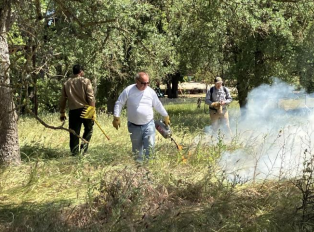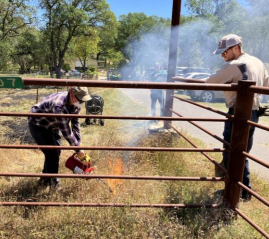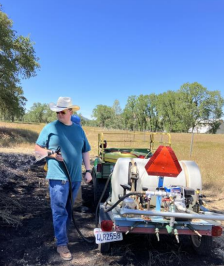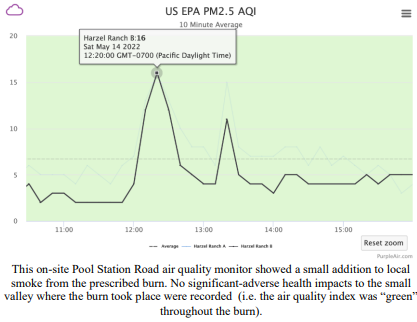Sonora, CA… The Mother Lode Prescribed Burn Association, which brings together local residents, landowners and fire
professionals in Calaveras and Tuolumne Counties, is gearing up for the next year of events. The goal of the group is to mentor landowners to use prescribed fire on their own properties. The group was convened in July 2021 by Susie Kocher, Forestry Advisor for the University of California Cooperative Extension in the central Sierra Nevada. “Prescribed Burn Associations or PBAs are groups of landowners helping each other to both learn how to use prescribed fire to manage their properties and to help each other carry it out. They have been common in other states in the Midwest and Southeast United States but are relatively new to California,” said Kocher. The first PBA was formed in Humboldt County in 2017 and now there are at least 20 in various stages of development throughout the state (http://calpba.org).




Mother Lode PBA burns to date
To date, the local group has held workshops on prescribed burn use and planning and held three landowner-led burn events. In December, landowners in Long Barn hosted 20 volunteers to help them burn 3 acres of forested property. In February, landowners in Camp Connell hosted 10 volunteers at a pile burning event. And in May, landowners in Angels Camp hosted 12 volunteers to burn about 2 acres of grassland. Volunteers have ranged from those with professional fire credentials to those with no experience burning at all. All events have served as educational opportunities for members to learn about the prescribed fire planning and implementation process and get more hands-on experience with live fire. The events often end with a shared meal and debriefing where all the volunteers talk about their experience and build camaraderie.
The May burn was held at a member’s property on Pool Station Road in unincorporated Angels Camp on May 14th. While the burn was originally slated to be held in conjunction with a burn-plan writing workshop held at Columbia College on April 22nd, late season rains forced the prescribed burn event to be delayed. Because a Calfire permit is required for burning after May 1st, the planning needed to be more extensive to secure a permit. PBA members Chuck Beckman and Mike Dvorak wrote a draft burn plan that included a detailed map showing
the property divided into burn units with fire control lines and location of water sources nearby. Cal Fire personnel then visited the property and provided feedback about the burn plan. “Having Cal Fire give us input about vegetation management, timing of the burn, and fire control was critical to the success of this prescribed burn,” said the landowner Mike Dvorak, adding that, “I was absolutely astonished with how supportive Cal Fire was through this entire prescribed burn permitting process.”
The 1.6 acre unit was burned over a three-hour period with 12 volunteers. The grass burned well in sunny spots but not so well in the shade. One of the goals was to consume Medusa head grass, an invasive species. Consumption of this invasive was good. Dvorak said, “We managed to burn about 20% of property this year alone, which should help to restore fire-adapted native plant species and put them on a more even footing with all the invasive species out there.” When taken together with other smaller prescribed burns near the house and creek bed, the May burn helped to develop defensible space for the property while also improving soil health.
One drawback to prescribed burns is a potential to send smoke towards neighbors that live close by. To deal with this, the PBA alerted neighbors in advance, placed large signs along the road to alert drivers to the prescribed burn, and placed a volunteer to manage traffic that was traveling too fast near the burn area. Smoke impacts were minimal, as measured by a PurpleAir monitor on site, due to the light breeze clearing the smoke and a complete mop up of the fire by mid-afternoon. “Although there can be a smoke impact from prescribed burns, it is generally very localized to the burners themselves and the immediate area. Prescribed fire smoke also helps reduce the risk of greater impacts from wildfire smoke which burns in much more extreme conditions at larger scale,” said Kocher.
Mother Lode PBA hires part-time coordinator
In June, the Tuolumne County Resource Conservation District was awarded funding through the CA Department of Conservation’s Regional Forest and Fire Capacity program to hire a part-time PBA coordinator. The Watershed Research and Training Center distributed these grants to eleven PBAs across the state to fund leadership, peer mentorship, and training and travel. The Tuolumne County RCD was awarded funding for a half-time coordinator for the next two years and has hired Claire Rappaport to fill the role. Rappaport has a background in prescribed fire use as a management tool on land owned by the State of California, and is looking
forward to bringing that experience to private landowners. Moving forward, Rappaport will work with PBA members to help coordinate burns during the burn season.
The group is actively working to continue helping landowners develop burn plans, and hopes to be ready for winter and spring burning. “The overall goal of the group is to help landowners learn how to put good fire on the ground on their own properties. Starting small, with a few acres burned by many landowners will help us increase the pace of scale of prescribed fire,” said Kocher.
For more information, please contact Claire Rappaport, claire@tcrcd.org
The work upon which this publication is based was funded in whole or in part through a grant awarded by the California Department of Conservation. The Mother Lode PBA is supported by the Watershed Research and Training Center, UC ANR and the Tuolumne Resource Conservation District.


